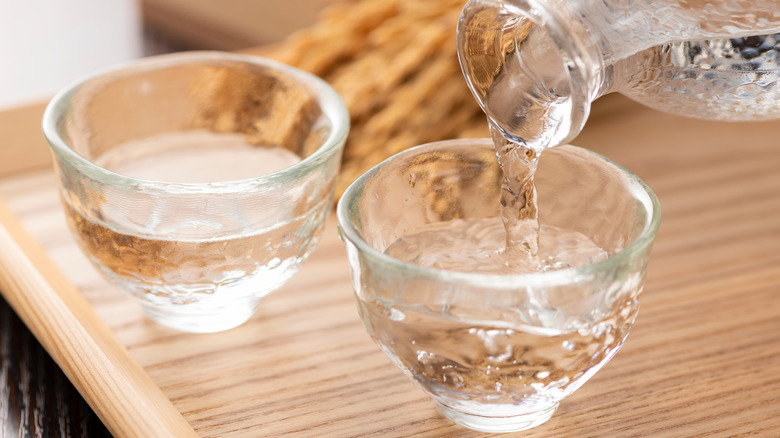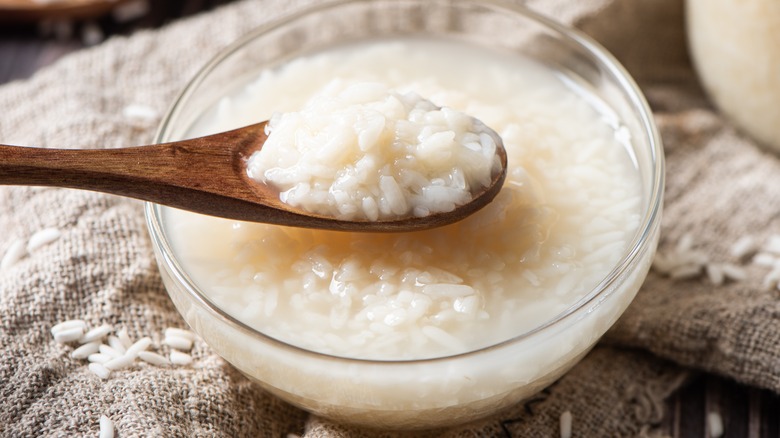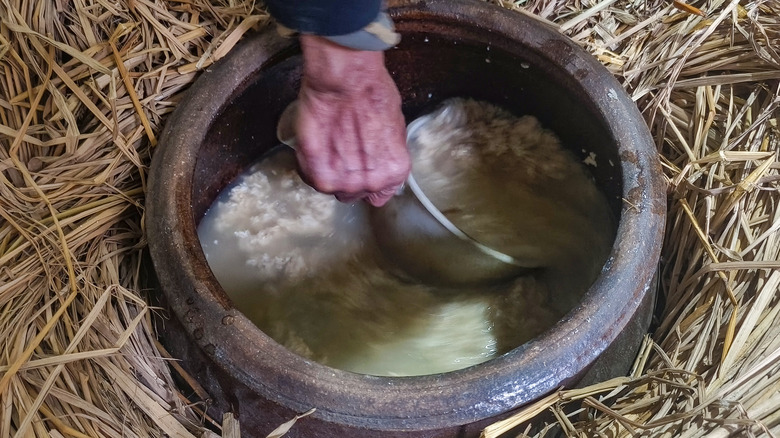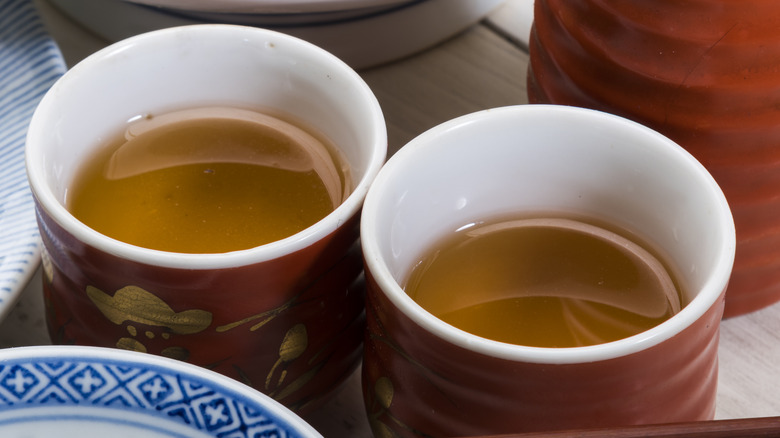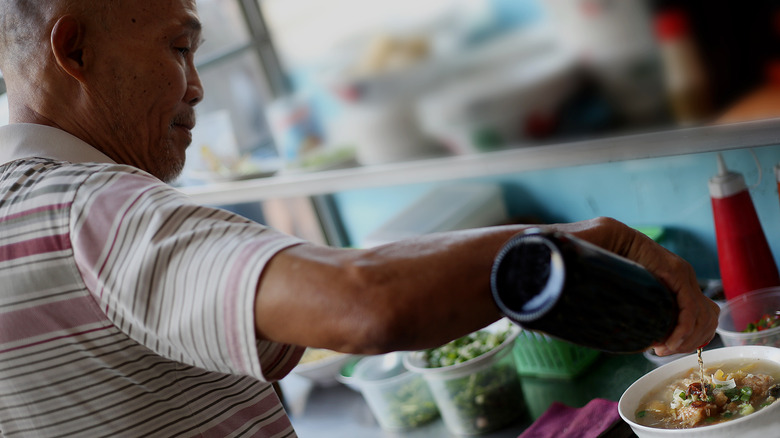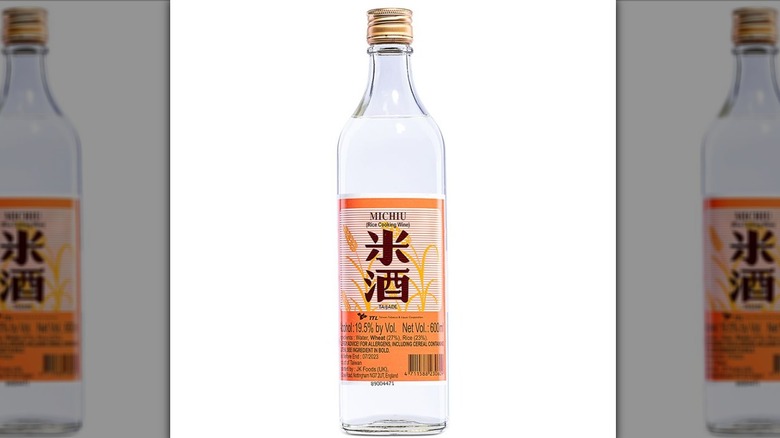Mijiu Is The Chinese Rice Wine You Should Be Cooking With
Booze doesn't just offer a delicious base for cocktails, but enhances cooking, too. From a splash of spirit in penne alla vodka to anise-flavored Pernod adding complexity to classic bouillabaisse, alcohol has a wide range of applications in the kitchen. Whether it's to deglaze your pan or go in as part of the sauce, the liquid adds a depth of flavor that's hard to replicate with non-alcoholic ingredients.
In China, rice wines are the alcohol of choice in the kitchen, and are a prominent fixture in various cooking applications. Chances are, you've already heard of Shaoxing wine, but it's not the only type out there. It actually belongs to a whole class known as mijiu, which includes everything from ceremonial liquors to bottles bought for personal enjoyment, as well as culinary-purpose ferments.
Particularly popular across China and Taiwan, mijiu encompasses a multitude of regional styles, many of which don't hit U.S. stores. So when you do see it on the shelves, snag it — it'll imbue a delicious note to cooking that's difficult to get from anything else.
What is mijiu?
Mijiu simply translates to fermented rice wine and encompasses many variations of Chinese alcoholic drinks, including Shaoxing wine. Mijiu has been produced and used in China for over 2,000 years since the Shang dynasty. Originally used for medicinal and ceremonial purposes, its consumption was mostly by the upper classes. Nowadays, there are many varieties, with regional variations across China.
However, typically, the term references the clear, colorless, or lightly tinged varieties, which range from 12-20% ABV. In China, these wines are enjoyed for drinking — either heated or cold — as well as for cooking. Reminiscent of sake, they boast a clear, slightly sweet flavor that's smooth and easy to enjoy. Unfortunately, the varieties made for imbibing are not often found outside of China. Most mijiu sold abroad has been heavily salted to avoid classification as an alcoholic beverage. The process doesn't diminish its culinary potential but does make it off-putting to drink straight.
How is mijiu made?
Mijiu is crafted from a type of raw, short-grain glutinous rice that clumps together when cooked. The rice is soaked in water for an hour or longer until the grains are fully hydrated with water and softened. Next, the rice is steamed, reaching a mushy, sticky consistency. Once cooled to room temperature, the fermentation process starts.
A yeast bacteria is introduced in the form of a ball called qu, which also contains a specific type of mold. The mixture is placed into an earthenware vessel called a jia, and left to ferment naturally for varying durations of up to a month. To stop the fermentation process, the liquid is cooled. Environmental factors like humidity, external temperature, and other conditions, all affect the mijiu, and like all distilling processes, each producer has their own set of specific rules. For the clear, colorless variety, no further ingredients are added to the mix, while other types may integrate additional flavorings.
Mijiu vs Shaoxing wine
Shaoxing wine is a type of mijiu; however, this subvariety has a much more distinct flavor and appearance than other rice wines. For starters, it's red-orange in color due to the use of a unique yeast, while most wines labeled as mijiu are clear. Additionally, Shaoxing wine employs a small amount of wheat, which means it's not gluten-free. It also carries its own distinct set of traditions, such as the burial of a bottle when a daughter turns a month old.
As opposed to mijiu's soft and mild flavor, Shaoxing has a more complex, multi-sensory taste. Due to the frequent addition of components — even spices in cooking variants — it can encompass sour, bitter, astringent, and pungent notes. While these add a specific depth to dishes and make for a unique drinking experience, this means the two rice wines have very different qualities in cooking. Shaoxing wine is used as a prominent flavoring, as opposed to mijiu's gently amplifying properties.
How to cook with mijiu?
Like other cooking alcohols, mijiu adds complexity and depth, especially when introduced at a high heat. It's used to deglaze a wok and can be used to create wok hei, all the while imparting a delicious, gentle flavor. Since it has a mild, not very dominant taste, it's typically used to lessen off-putting notes and amplify a dish rather than offer a definitive flavor.
It is especially popular for use alongside seafood, gamey meats, and dark-meat poultry. In Taiwan, a common dish with mijiu is known as san bei ji — or three-cup chicken. The condiment is paired with soy sauce, sesame oil, and herbs to braise dark meat chicken to tender perfection. Alternatively, rice wine is used in marinades and added to water for boiling drumsticks.
Mijiu can be used for sweet applications, too. It's often reduced with cherries into a compote-like creation. Or, it's one of the components of glutinous rice balls, a popular sweet treat. A pantry staple in China, rice wine has a myriad of uses in Chinese cooking.
Where to buy mijiu?
Look for mijiu in Asian specialty grocery stores, especially with large selections of Chinese produce. It should be in the sauce aisle, next to vinegar, soy sauce, and other condiments. Alternatively, look for mijiu online. Keep in mind it's often spelled differently as michiu, or translated to rice cooking wine.
Once purchased, store it in a cool, dry, dark place. Make sure to screw the cap on tightly after opening, and it will last up to six months. While mijiu does not have to be refrigerated, some choose to cool it to extend its shelf life.
Unfortunately, mijiu does not have a straightforward substitution, so to create authentic Chinese recipes, it's a condiment worth obtaining. The closest alcohols include gin, which has a similar effect during cooking, as well as some dry sherries. While also colorless, don't confuse mijiu with mirin, as the latter has a much bolder, sweeter flavor.
